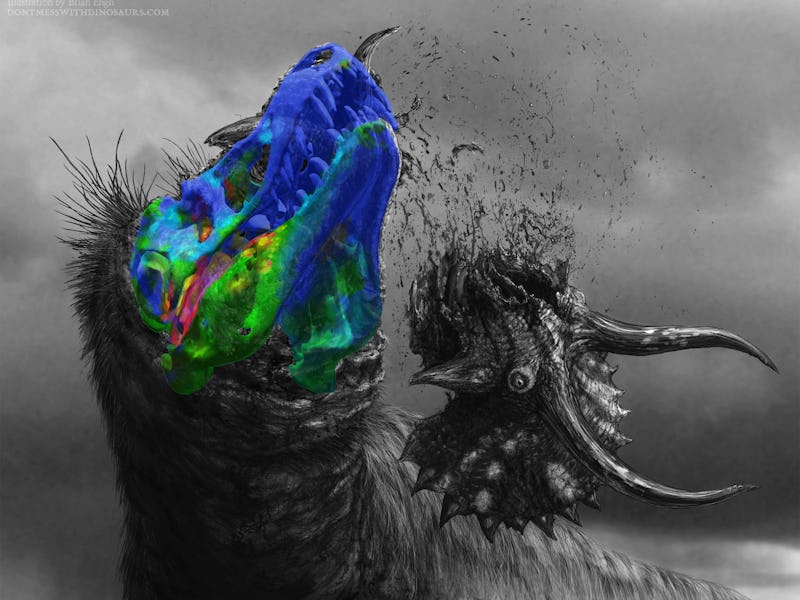Parrot and gecko skulls reveal why T. rex had such a powerful bite
The stiffer the skull, the stronger the bite.

The deadly power of Tyrannosaurus rex’s massive bite presents a paradox: How did it use its bones to crush other animals’ bones without breaking its own bones in the process? After all, teeth, jaws, and skulls are all made of bone, so why shouldn’t gnashing and bashing bones together result in a huge mess of fractures all around?
This question may not immediately come to mind for someone with a brain that’s focused on more important matters, but once I started thinking about it, it became extremely difficult to stop wondering. Fortunately, I’m not alone: A team of scientists wondered the exact same thing, and in research released this summer in The Anatomical Record, they explained how the anatomy of T. rex’s head made it possible for the animal to bite down with over 12,000 pounds of force without fear of hurting its skull.
In a study published on July 1, they proposed that the extremely taut muscles, ligaments, and cartilage in T. rex’s face and head helped keep its jaw aligned and its skull stiff during its deadly bites.
Modern reptiles and birds, on one hand, have skulls that flex considerably when they bite. Cranial joints, including where the jaw meets the rest of the skull, all flex when these modern descendants of dinosaurs bite down on their meals.
T. rex, on the other hand, kept its skull completely stiff. Watch the three videos in this article to see the huge difference among the dinosaur and its distant distant modern relatives.
“The T. rex had a skull that’s 6 feet long, 5 feet wide and 4 feet high, and bites with the force of about 6 tons,” Kaleb Sellers, a Ph.D. student in the University of Missouri School of Medicine and one of the paper’s co-authors, said in a statement.
“Previous researchers looked at this from a bone-only perspective without taking into account all of the connections — ligaments and cartilage — that really mediate the interactions between the bones.”
Using the skulls and muscular anatomy of an African grey parrot (Psittacus erithacus) and a tokay gecko (Gekko gecko), the team built a simulation of the forces that would deform their skulls as they bit down on their prey. Applying the same principles to a T. rex skull, their models found almost no flexing.
This finding overturns years of research on how the dinosaur’s powerful bite worked.
As the team writes in the paper, the T. rex has ball-and-socket joints in its jaw, much like the ones we have in our hips. These joints were passed down from the dinosaur’s fish ancestors. Because of this, multiple previous studies had proposed that T. rex’s skull flexed when it chomped.
The tokay gecko's skull, which deforms as the animal bites, provided researchers with a comparison for T. rex's skull.
So whereas the roof of the gecko and parrot’s mouths flexed when the animals bit down, the T. rex’s stayed nearly completely stationary. These observation showed that the dinosaur had an extremely powerful bite that was made more stable by its stiffness.
“When you put a lot of force on things, there’s a tradeoff between movement and stability. Birds and lizards have more movement but less stability,” said Sellers.
“When we applied their individual movements to the T. rex skull, we saw it did not like being wiggled in ways that the lizard and bird skulls do, which suggests more stiffness.”
Abstract: The extinct nonavian dinosaur Tyrannosaurus rex, considered one of the hardest biting animals ever, is often hypothesized to have exhibited cranial kinesis, or, mobility of cranial joints relative to the braincase. Cranial kinesis in T. rex is a biomechanical paradox in that forcefully biting tetrapods usually possess rigid skulls instead of skulls with movable joints. We tested the biomechanical performance of a tyrannosaur skull using a series of static positions mimicking possible excursions of the palate to evaluate Postural Kinetic Competency in Tyrannosaurus. A functional extant phylogenetic bracket was employed using taxa, which exhibit measurable palatal excursions: Psittacus erithacus (fore–aft movement) and Gekko gecko (mediolateral movement). Static finite element models of Psittacus, Gekko, and Tyrannosaurus were constructed and tested with different palatal postures using anatomically informed material properties, loaded with muscle forces derived from dissection, phylogenetic bracketing, and a sensitivity analysis of muscle architecture and tested in orthal biting simulations using element strain as a proxy for model performance. Extant species models showed lower strains in naturally occurring postures compared to alternatives. We found that fore–aft and neutral models of Tyrannosaurus experienced lower overall strains than mediolaterally shifted models. Protractor muscles dampened palatal strains, while occipital constraints increased strains about palatocranial joints compared to jaw joint